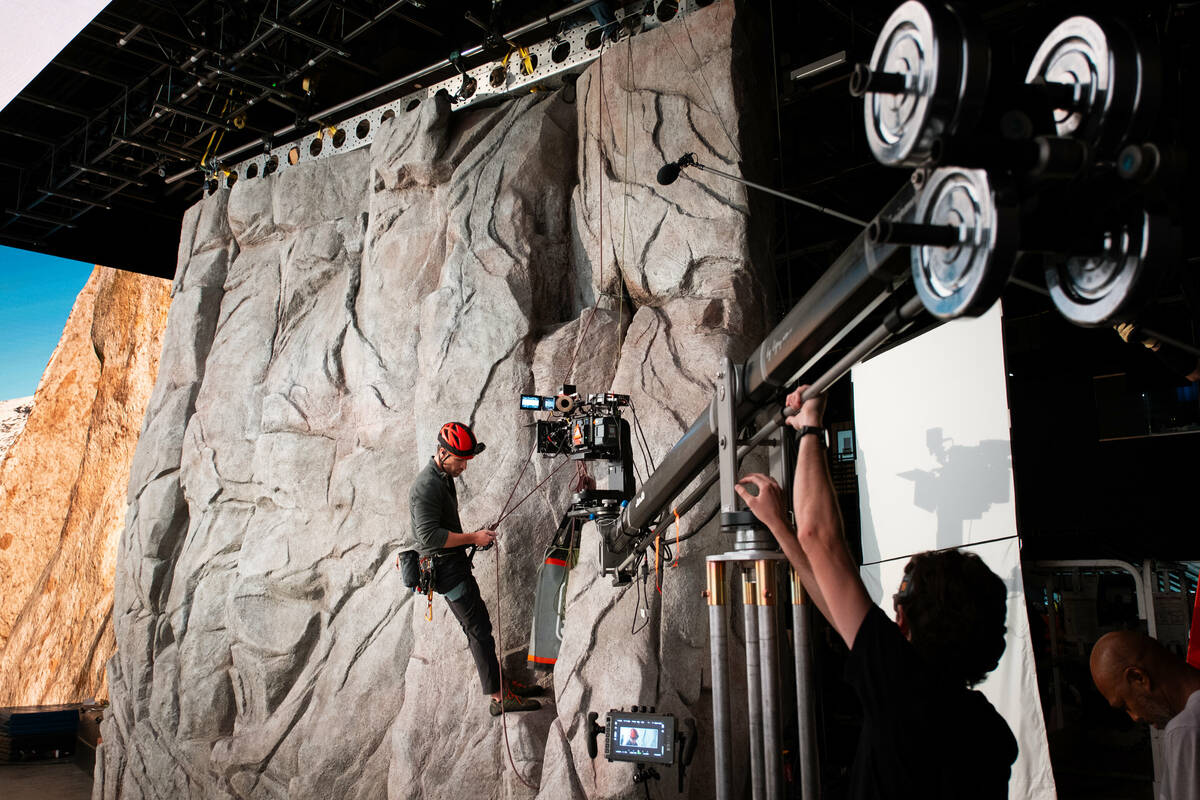How Hollywood productions cash in on Nevada tax credits
Whether it’s a TV show about changing someone’s life, an indie film about a Vegas crooner or an action movie about the hunt for a serial killer in the Southwest, production companies are raking in the chips to film their movies and TV shows in Nevada by qualifying for more than $5.1 million in tax breaks.
But they don’t keep the winnings to themselves. Companies transferred roughly $4.5 million of those tax incentives to other Nevada businesses in the last fiscal year, according to a draft report on Nevada’s existing transferable tax credit program.
As policymakers in Carson City consider reviving a proposal to substantially expand the incentive program to help develop a film studio campus in Southern Nevada, the annual report sheds light on how these tax breaks are used in practice.
The concept to build Summerlin Studios near South Town Center Drive and West Flamingo Road was one of the biggest public policy debates in the 2025 Nevada Legislature’s session. It passed out of the Assembly 22-20 in the waning days of the 120-day session, but was not considered in the Senate before adjournment in June.
The proposal as introduced in the regular session could have awarded more than $1 billion in tax credits over 15 years. Details of the legislation could change if introduced during a special session.
How Nevada’s program works
The state’s existing film tax credit program gives a 15 to 25 percent tax credit to qualifying productions but is capped at $10 million annually. To qualify for the baseline 15 percent credit, at least 60 percent of the production’s overall budget’s costs must be incurred in Nevada, including pre-production, with at least $500,000 in production expenditures.
Additional 5 percent bonuses are available for productions if at least half of their below-the-line personnel — technical and logistical crew members — are Nevada residents, and if the production spends more than half of its filming days outside of Clark County.
The tax credits are used to reduce a production’s tax liability. They can be used against the insurance premium tax, a tax levied on insurance companies based on policy premiums in the state; the modified business tax, a payroll tax levied on employers; and gaming license fees.
Transferable tax credits are notable because the recipients can transfer unused credits to other businesses. Most often, these tax credits are sold at a discount to businesses outside the industry — most often in the insurance and gaming industries.
Details about the companies that purchased the credits and how much they paid is not public information because of confidentiality laws for the Department of Taxation.
But the practice of buying transferable tax credits from film companies at a discount is common in the industry. For example, if a film production is awarded a $1 million tax credit, it may find a casino or insurance company buyer interested in the credit and sell the $1 million credit for $800,000.
In that arrangement, the production company gets an $800,000 cash infusion while the purchasing company uses the full $1 million credit toward its own tax liabilities, reducing its tax obligations by the face value of the credit but at a discount to the company’s books.
2025 report details
A preliminary annual report from Film Nevada, the state office responsible for administering the program, found that about $11.4 million in credits were awarded to new applicants during the most recent fiscal year. (State officials can award more than $10 million annually by using unused funds from previous years.)
The report, which is due to the Legislature each October, is considered a draft because its verification process was delayed by the August cyberattack on the state. A spokesperson from the Governor’s Office of Economic Development, which houses the film office, said a final version of the report will be verified and expanded to include an economic impact analysis.
Ten audits were completed during the 2025 fiscal year, the draft report states. The productions qualified for nearly $5.2 million in transferable tax credits based on more than $31.3 million in qualifying expenditures in the state. They hired 2,527 people in Nevada, including above-the-line and below-the-line workers and background extras.
The draft report states that $3.6 million of the credits were used, including some that were transferred in previous years and then applied to the buyer’s tax burden in the 2025 fiscal year.
Audits largely covered productions that occurred in 2023 and 2024. Film Nevada Director Kim Spurgeon said in an emailed statement that is because of the timing of the program. An approved applicant has 90 days to start filming and 18 months to finish production once principal photography begins. Some productions include post-production in their application, adding to the timeline.
Audits are required after filming is completed and the last Nevada expenses are incurred. The third-party review, followed by verification from Film Nevada, determines the final incentive amount.
Mark Wahlberg, Mel Gibson and Seth Rogen film in Nevada
Here are some of the larger awardees audited in the 2025 fiscal year, according to the draft report.
— “Flight Risk”: Mel Gibson directed and Mark Wahlberg starred in this action movie that was released in January. The production filmed in Nevada in June and July 2023. It received about $1.3 million in tax credits, which were transferred to an insurance company to use on the insurance premium tax and was applied during the 2025 fiscal year.
— “Easy’s Waltz”: Vince Vaughn, Al Pacino and Shania Twain make it on screen in this indie drama that premiered at the Toronto International Film Festival this fall. It received the second-highest credit amount, nearly $1.3 million. The tax credit was transferred to a gaming company to use against gaming license fees, but the buyer had not used it as of June 30.
— “The Studio”: The last two episodes of the first season of this Apple TV comedy series were filmed at The Venetian. The show, starring Seth Rogen, was primarily filmed in June 2024, and the episodes were released this May. The episodes, considered under separate applications, received roughly $685,000 combined, which was transferred for gaming license fees and used during the fiscal year.
— “Queer Eye”: Season 9 of Netflix’s make-over reality show largely filmed in March through May 2024 in Las Vegas and aired in December. The production received $604,386, which was issued in the 2025 fiscal year but transferred to an insurance company in the next year to be applied to the insurance premium tax.
— “Boneyard”: Mel Gibson and Curtis “50 Cent” Jackson star in this action movie released in June 2024. The production was filmed primarily in Nevada in April 2023 and transferred its $386,770 credit to an insurance company for the insurance premium tax, which was used in the 2025 fiscal year.
Economic impact details to come
An economic impact analysis was not included in the draft report — an important metric that is at the center of the Summerlin Studios debate. The measure represents the estimated economic impact per dollar of transferable tax credit and is different than a fiscal return on investment, which estimates the net new taxes per dollar of the credit.
Policymakers and advocates look to the economic impact to determine whether the forgone tax revenue is worthwhile for the broader state economy.
The state’s 2024 report determined that the state’s fiscal return on investment was 30 cents in tax revenue for every dollar in tax credits used, while the economic return on investment was $15 per tax dollar.
Audited productions spent about $30.1 million in qualified expenditures during that fiscal year, including construction and set dressing, equipment rentals, locations, wardrobe and hair/makeup, travel, accommodations and catering, according to the 2024 report, compared with qualified expenditures of about $31.3 million in the 2025 fiscal year, according to the draft 2025 report.
Contact McKenna Ross at mross@reviewjournal.com. Follow @mckenna_ross_ on X.





















